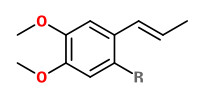Dies ist eine alte Version des Dokuments!
Asarum europaeum L.- syn.Asarum officinale Moench. - Aristolochiaceae
asarabacca, European snake root, hazelwort, (Europäische) Haselwurz, Brechwurz
Prostrate evergreen perennial, up to 10cm high, with a creeping branched rhizome, native to Central and South Europe; whole plant tomentose; stems short, developing in spring, each with two leaves; leaves leathery, shiny dark green, reniform (kidney-shaped), stalkes reddish brown; flowers solitary, axillary, dark purple-brown, campanulate; fruit a many-seeded capsule.
The anaesthetic activity of (E)-asarone (= α-asarone, trans-isoasarone) and (E)-methyl isoeugenol (isoeugenol methyl ether), both phenylpropanoids of A.europaeum, were measured in comparison to the unsubstituted propenyl benzene and to the mono methoxy derivative trans-anethole resp. benzocaine. (E)-asarone showed local anaesthetic activity with an intensity nearly equal to benzocaine.
[The Active Substances of Asarum europaeum., Gracza, L., Planta medica, 48(7), 1983, 153-157]
„The locally strong irritant effect and the pepper-like burning taste of the drug is ascribed to trans-isoasarone… Extracts of the drug cause vomit, laxative and diuretic. In former times, the rhizome was used as emetic and sneezing powder. The root was used in folk medicine to treat diseases of the kidney, bladder, liver, and inflammation of the upper respiratory tract. Further application of the decoction is not encouraged, as side effects can not be excluded.“
[BI-Lexikon Heilpflanzen und Drogen, Ennet D., Leipzig 1990, 134]
A.europaeum essential oil of Romanian origin showed concentrations of 460-510 μg/ml for α-asarone (= (E)-asarone) and 24-29 μg/ml for β-asarone (= (Z)-asarone).
[Comparison of GC-MS and TLC techniques for asarone isomers determination., Oprean, R., Tamas, M., Roman, L., Journal of pharmaceutical and biomedical analysis, 18(1), 1998, 227-234]
„Different parts of Acorus calamus L. (Araceae) and Asarum europeaum L. (Aristolochiaceae) growing in Poland were subjected to headspace-SPME (HS-SPME) and the same plant material were hydrodistilled (HD) to obtain the profiles of their volatile constituents. In both cases, compounds of essential oils and headspace volatiles were identified and quantified by GC and GC/MS. The results showed that the similar compounds were detected in the vapor phases and in the oils derived from both plants. … The analysis of the oil and the SPME headspace of roots of A. europaeum led to detection of 34 and 34 compounds representing 86.9% and 80.5% of the total components detected, respectively. The main compounds of the oil were (E)-asarone, 59.1% and bornyl acetate, 7.5%. And the leading constituents of SPME phase of roots were (E)-asarone, 57.3% and bornyl acetate, 8.3%.“
[Comparison of volatile constituents of Acorus calamus and Asarum europaeum obtained by different techniques., Wilczewska, A.Z., Ulman, M., Chilmończyk, Z., Maj, J., Koprowicz, T., Tomczyk, M., Tomczykowa, M., Journal of Essential Oil Research, 20(5), 2008, 390-395]
The dried rhizome (Radix Asari, Rhizoma Asari, Asari radix, Haselwurzwurzel) owns a spicy, camphor-like odor and pepper-like, spicy, bitter taste. Pulverized material serves as sneezing powder. The drug contains an essential oil (0.7-4.1% dry weight, rootlets 2.1%) with variable composition. Main constituents are (E)-asarone (0.5-70%), (E)-methyl isoeugenol (0.5-40%), and (E)-isoelemicin (0.5-45%).
[Hagers Handbuch der Pharmazeutischen Praxis, Springer 2010]
In 2010, the use of all plants belonging to the Asarum species in drugs was banned in Germany by decree of the Federal Institute for Drugs and Medical Devices (BfArM). The cause of this was the detection of aristolochic acid I in homeopathic mother tinctures of Asarum europaeum with approximately 0.044 - 0.13 ppm, and of Asarum canadense with approximately 127.4g/kg (about 0.13 ppm).
http://www.bfarm.de/SharedDocs/Downloads/DE/Arzneimittel/Pharmakovigilanz/Risikoinformationen/RisikoBewVerf/a-f/aristolochia_bescheid.pdf?__blob=publicationFile&v=2

Thomé,O.W., Flora von Deutschland Österreich und der Schweiz, Tafeln, vol.3 t.456 (1885)
http://plantgenera.org/species.php?id_species=95879

